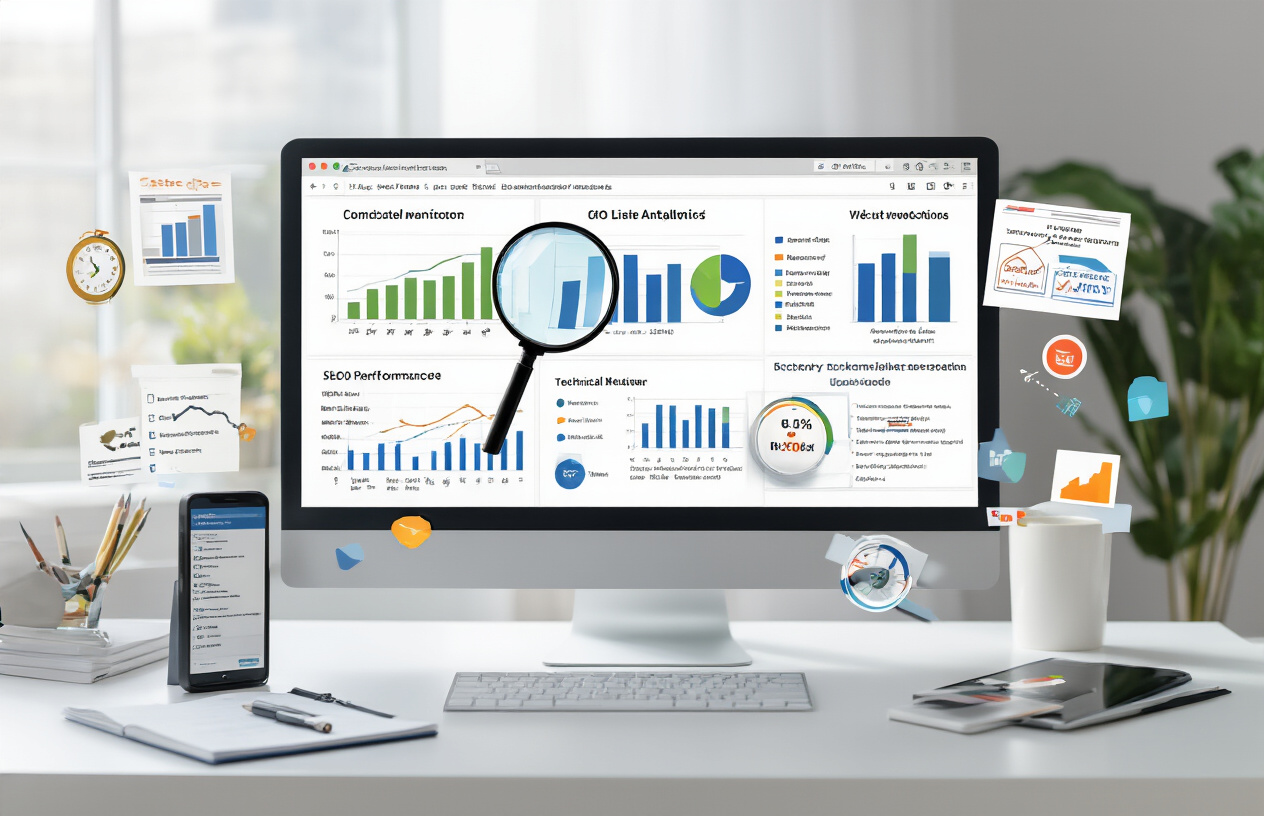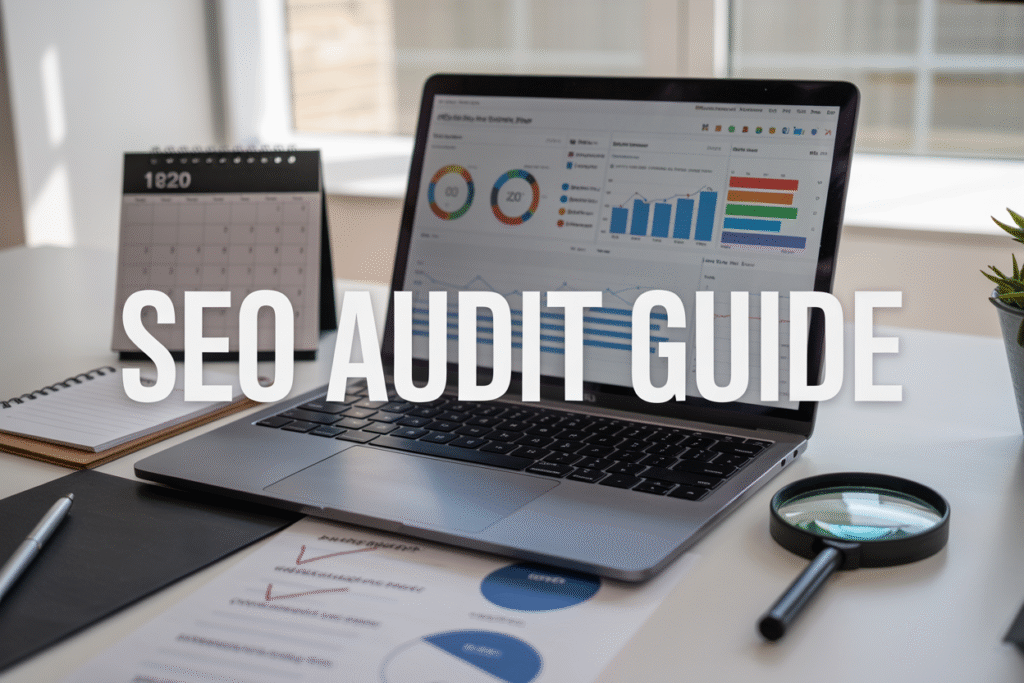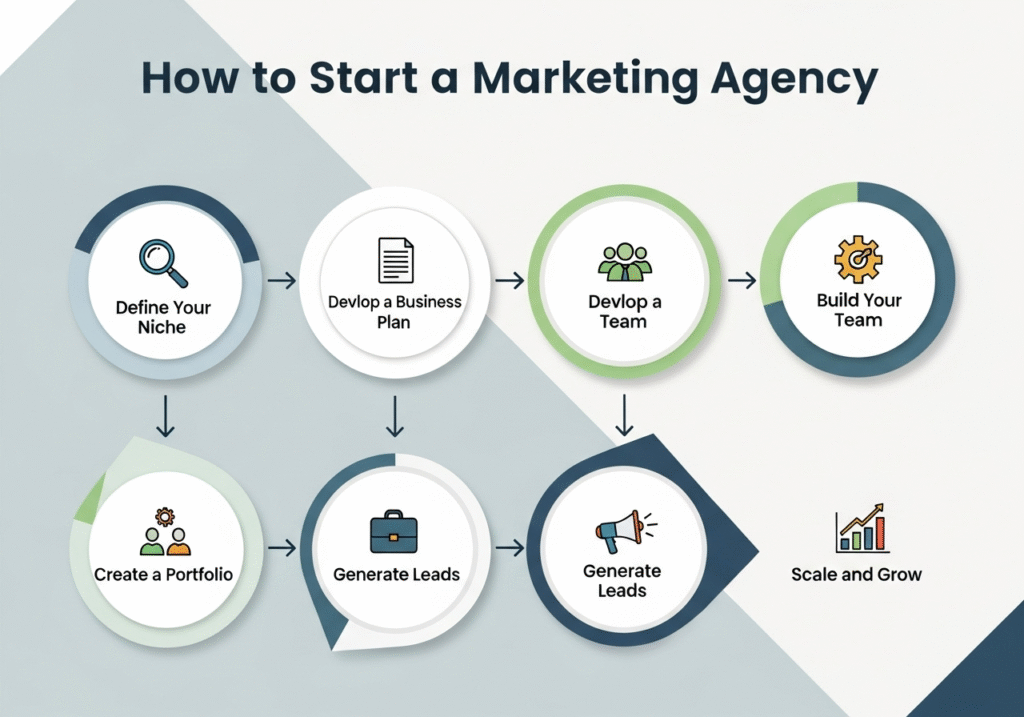How many times should you audit your site for SEO? SEO audits shouldn’t be a once-and-done deal, but figuring out exactly how many times you should audit your site for SEO can feel overwhelming. Most website owners and digital marketers struggle with this timing question, often waiting too long between audits or checking too frequently without clear purpose.
This guide is designed for business owners, marketing managers, and SEO professionals who want to establish a smart SEO audit frequency that actually drives results. Whether you’re managing a small business website or overseeing multiple enterprise sites, you need a clear roadmap for when and how often to conduct your website SEO check.
We’ll walk you through the fundamentals of SEO audit timing, helping you understand why different website types need different audit schedules. You’ll also discover the warning signs that should trigger an immediate technical SEO audit, plus learn how to create a personalized audit calendar that maximizes your SEO strategy investment without wasting time or resources.
Understanding SEO Audit Frequency Fundamentals

What constitutes a comprehensive SEO audit
A comprehensive SEO audit is like getting a complete health checkup for your website. It involves systematically examining every aspect that influences your site’s search engine performance, from technical infrastructure to content quality. The audit covers three main pillars: technical SEO, on-page optimization, and off-page factors.
Your technical SEO audit dives deep into website architecture, crawlability issues, site speed, mobile responsiveness, and server configurations. This includes checking for broken links, duplicate content, XML sitemaps, robots.txt files, and schema markup implementation.
The on-page SEO audit evaluates content quality, keyword optimization, meta tags, header structures, and internal linking patterns. This component ensures your content aligns with search intent and follows SEO best practices for maximum visibility.
Off-page analysis examines backlink profiles, domain authority, and external signals that impact your search rankings. A thorough website SEO check also includes competitor analysis and market positioning assessment.
Key factors that determine audit timing
Several variables influence how many times you should audit your site for SEO throughout the year. Website size plays a crucial role – enterprise sites with thousands of pages require more frequent monitoring than small business websites with 20-30 pages.
Industry competitiveness directly impacts SEO audit frequency. Highly competitive sectors like finance, healthcare, or e-commerce demand more regular assessments because competitors constantly optimize their strategies. Algorithm updates from search engines also trigger the need for immediate audits.
Business growth phases significantly affect timing. Rapidly expanding companies launching new products, entering new markets, or undergoing website migrations need quarterly audits minimum. Stable businesses might manage with semi-annual comprehensive reviews.
Resource availability matters too. Teams with dedicated SEO specialists can conduct monthly mini-audits, while smaller organizations might schedule comprehensive audits twice yearly and rely on ongoing monitoring tools for interim insights.
Difference between full audits and ongoing monitoring
Full audits and ongoing monitoring serve different purposes in your SEO strategy. Think of full audits as comprehensive medical exams – they’re thorough, time-intensive evaluations that uncover deep-seated issues and opportunities across your entire digital presence.
Ongoing monitoring acts like daily health tracking. It continuously watches key metrics such as organic traffic, keyword rankings, page load speeds, and crawl errors. This approach catches problems early before they damage your search performance significantly.
| Aspect | Full Audits | Ongoing Monitoring |
|---|---|---|
| Frequency | Quarterly/Bi-annually | Daily/Weekly |
| Scope | Comprehensive | Targeted metrics |
| Time Investment | 40-80+ hours | 2-5 hours weekly |
| Cost | Higher upfront | Lower ongoing |
| Problem Detection | Deep issues | Surface-level alerts |
Full audits require dedicated time blocks and often external expertise, while monitoring can be automated using tools like Google Search Console, analytics platforms, and SEO monitoring software. Smart businesses combine both approaches – using monitoring for quick issue identification and full audits for strategic planning and deep optimization.
Impact of audit frequency on search rankings
Regular SEO audits directly correlate with improved search rankings, but the relationship isn’t always linear. Websites that conduct quarterly comprehensive audits typically see 20-35% better organic traffic growth compared to those auditing annually or less frequently.
The timing sweet spot varies by website type, but data shows diminishing returns beyond monthly full audits for most sites. Over-auditing can lead to constant strategy pivoting without allowing changes time to take effect, potentially hurting rankings through inconsistent optimization approaches.
Consistent audit schedules help identify ranking fluctuations early. Sites with regular technical SEO audits catch crawling issues, broken redirects, and performance problems before they significantly impact visibility. This proactive approach maintains steady ranking momentum rather than reactive recovery periods.
Search engines favor websites that demonstrate consistent optimization efforts. Regular audits ensure your site meets evolving algorithm requirements, maintains technical health, and stays competitive with fresh, optimized content. The compound effect of frequent optimization creates sustainable ranking improvements that outperform sporadic, intensive efforts.
Essential SEO Audit Schedule Based on Website Type

E-commerce sites require monthly comprehensive reviews
Online stores need frequent attention because their SEO landscape changes rapidly. Product inventories shift, seasonal campaigns launch, and customer search patterns evolve constantly. A monthly SEO site audit catches critical issues before they impact your bottom line.
Focus your monthly reviews on product page optimization, category structure analysis, and technical SEO audit elements like site speed and mobile performance. E-commerce sites typically deal with duplicate content issues from product variations, broken internal links from discontinued items, and crawl budget problems from large catalogs.
Track your organic traffic patterns, conversion rates from search, and keyword rankings for your top revenue-generating products. This frequency helps you stay ahead of competitors who might be targeting your valuable commercial keywords.
Corporate websites benefit from quarterly assessments
Business websites operate on longer content cycles and structural changes happen less frequently. A quarterly SEO audit schedule aligns perfectly with most corporate planning cycles and budget reviews.
Your quarterly website SEO check should examine brand keyword performance, local SEO factors if applicable, and content freshness across service pages. Corporate sites often struggle with outdated information, inconsistent messaging across departments, and technical issues that accumulate over time.
Pay special attention to your website’s authority signals, backlink profile health, and competitive positioning during these reviews. This timeframe allows you to implement substantial improvements and measure their impact before the next audit cycle.
Blog-focused sites need bi-annual deep dives
Content-heavy websites with regular publishing schedules can maintain SEO health with thorough bi-annual audits. Your content creation workflow naturally addresses many ongoing optimization needs.
During your twice-yearly deep dive, analyze content performance patterns, internal linking opportunities, and topic cluster optimization. Blog sites benefit from comprehensive content gap analysis and keyword cannibalization reviews that quarterly audits might miss.
Examine your site architecture for content discoverability issues and evaluate whether your category structure still serves your expanded content library effectively.
New websites demand weekly monitoring in first 3 months
Fresh websites need intensive SEO strategy support during their critical launch period. Weekly monitoring catches indexing issues, technical problems, and optimization opportunities while search engines are still learning about your site.
Your weekly checks should include Google Search Console monitoring, crawl error identification, and basic ranking tracking for target keywords. New sites often experience fluctuating visibility as search algorithms evaluate content quality and user engagement signals.
This intensive monitoring phase establishes strong SEO foundations and prevents small issues from becoming major problems later.
High-traffic sites require continuous oversight
Websites handling significant daily traffic volumes need ongoing SEO attention because small changes can have massive impact. Implement automated monitoring tools alongside manual reviews to catch issues quickly.
Your continuous oversight should include real-time performance tracking, immediate technical issue alerts, and regular competitive analysis. High-traffic sites face unique challenges like server performance under load, complex user journey optimization, and maintaining quality standards across large content volumes.
Consider implementing daily automated checks for critical metrics while conducting formal comprehensive audits monthly or quarterly depending on your site’s complexity and change frequency.
Warning Signs That Trigger Immediate SEO Audits

Sudden drops in organic traffic patterns
Your website traffic usually follows predictable patterns, but when those numbers suddenly nosedive without warning, it’s time for an immediate SEO site audit. A drop of 20% or more in organic traffic within a short timeframe signals something serious has happened to your search visibility.
Traffic drops can stem from various issues: technical problems like broken redirects, indexing errors, or server downtime that search engines couldn’t crawl your pages. Sometimes Google penalties hit without you realizing it, especially if you’ve unknowingly acquired spammy backlinks or violated content guidelines.
Don’t wait to see if traffic recovers on its own. Quick action can prevent further damage and help you identify whether the issue is technical, algorithmic, or competitive. Monitor your analytics weekly to catch these drops early, and have your technical SEO audit checklist ready to deploy immediately.
Google algorithm updates affecting your niche
Google releases hundreds of algorithm updates yearly, but major ones can shake up search rankings overnight. When Google announces updates like Core Updates, Helpful Content Updates, or E-A-T focused changes, websites in certain niches face significant ranking shifts.
Your industry might be particularly vulnerable to specific updates. Healthcare, finance, and YMYL (Your Money or Your Life) sites often see dramatic changes during E-A-T updates, while content-heavy sites get hit during Helpful Content rollouts.
Stay connected to SEO news sources and Google’s official announcements. When an update targets your niche directly, conduct a comprehensive website SEO check focusing on the update’s specific criteria. Don’t assume you’re safe just because traffic hasn’t dropped yet – proactive auditing helps you strengthen weak areas before they become problems.
Major website redesigns or migrations
Website redesigns and migrations create the perfect storm for SEO disasters. New URLs, changed site structure, updated content, and different technical setups can destroy years of search engine optimization work if not handled carefully.
Before launching any major changes, perform a complete SEO audit to establish baseline metrics. After going live, audit again within 48 hours to catch immediate issues like broken redirects, missing meta tags, or crawl errors. Many sites lose 30-50% of their organic traffic during poorly managed migrations.
Common post-launch problems include:
- Broken internal linking structure
- Missing or duplicated meta descriptions
- Incorrect canonical tags
- Lost schema markup
- Slow page loading speeds
Schedule follow-up audits at one week, one month, and three months post-launch to ensure your SEO strategy remains intact throughout the transition period.
Competitor ranking improvements in your space
When competitors suddenly outrank you for important keywords, they’ve likely improved their website optimization or digital marketing SEO approach. Rather than watching your market share shrink, use their success as a trigger for immediate competitive analysis and SEO auditing.
Analyze what competitors are doing differently: Are they targeting new keywords? Have they improved their content quality or technical performance? Maybe they’ve earned high-authority backlinks or optimized their on-page SEO audit elements more effectively.
Use tools to compare your site’s performance against theirs across key metrics like page speed, content depth, keyword targeting, and backlink profiles. This competitive intelligence helps you identify gaps in your current SEO checklist and prioritize improvements that directly counter their advantages.
Quick competitor movement often signals broader industry shifts or new optimization opportunities you’re missing. Acting fast helps you regain lost ground before the gap widens further.
Core Elements to Evaluate in Each Audit Cycle

Technical SEO Health and Crawlability Issues
Search engines need to easily access and understand your website’s structure before they can rank your pages effectively. During each SEO audit frequency cycle, check your robots.txt file to make sure you’re not accidentally blocking important pages from search engine crawlers. Look for broken links that create dead ends for both users and bots – these hurt your site’s overall authority and user experience.
XML sitemaps deserve special attention in your website SEO check routine. Verify that your sitemap is up-to-date, properly formatted, and submitted to Google Search Console. Missing pages or incorrect URLs in your sitemap can prevent new content from getting indexed quickly.
Don’t overlook crawl errors and server response codes. A sudden spike in 404 errors or server timeout issues can seriously impact your search rankings. Your technical SEO audit should also examine site architecture and internal linking patterns. Deep pages that require more than three clicks to reach often struggle to gain search visibility.
| Technical Element | Check Frequency | Impact Level |
|---|---|---|
| Robots.txt | Monthly | High |
| XML Sitemap | Bi-weekly | High |
| Crawl Errors | Weekly | Critical |
| Site Architecture | Quarterly | Medium |
Content Quality and Keyword Optimization Gaps
Content remains the backbone of successful SEO strategy, making regular content audits essential for maintaining search visibility. Start by identifying pages with declining organic traffic – these often signal content that needs refreshing or keyword optimization updates. Search algorithms constantly evolve, and content that ranked well six months ago might need adjustments to stay competitive.
Your on page SEO audit should examine title tags and meta descriptions across all pages. Look for duplicates, missing elements, or descriptions that don’t accurately reflect page content. These small details significantly influence click-through rates from search results.
Keyword cannibalization presents another common issue during content reviews. Multiple pages targeting the same keywords compete against each other, diluting your overall ranking potential. Consolidate similar content or adjust keyword targeting to give each page a distinct purpose.
Content freshness matters more for certain topics than others. News-related content, trending topics, and time-sensitive information need regular updates to maintain relevance. Static pages like “About Us” or service descriptions require less frequent attention but should still align with current business offerings.
Backlink Profile Changes and Toxic Link Removal
Your backlink profile constantly changes as other websites link to or remove links from your content. Regular monitoring helps you spot both opportunities and potential penalties before they impact your rankings. New high-quality backlinks deserve celebration and analysis – understanding what content attracts quality links helps inform future content creation.
Toxic links pose a serious threat to your website optimization efforts. These low-quality or spammy links can trigger manual penalties or algorithmic demotions. During each audit cycle, review your newest links using tools like Google Search Console or third-party backlink analyzers.
Domain authority changes among linking sites also affect your link value. A previously valuable link might lose its impact if the linking domain’s authority drops significantly. Track these changes to understand shifts in your overall link profile strength.
- Monitor new backlinks monthly
- Audit link quality quarterly
- Check for broken backlinks bi-monthly
- Review anchor text distribution regularly
- Document disavow file updates
Lost backlinks hurt just as much as gaining toxic ones. Track when high-value links disappear and reach out to webmasters when appropriate. Sometimes a simple email can restore a valuable connection that was accidentally removed during a website redesign.
Page Speed and Mobile Responsiveness Metrics
Page speed directly influences both user experience and search rankings, making it a critical component of any digital marketing SEO strategy. Google’s Core Web Vitals have made speed optimization more important than ever. Your SEO checklist should include regular monitoring of Largest Contentful Paint (LCP), First Input Delay (FID), and Cumulative Layout Shift (CLS) scores.
Mobile responsiveness testing can’t be overlooked when most searches happen on mobile devices. Test your pages across different screen sizes and devices to catch responsive design issues. Navigation menus, forms, and interactive elements often break on smaller screens even when the main content displays correctly.
Image optimization represents low-hanging fruit for speed improvements. Compress images without sacrificing quality, implement lazy loading for below-the-fold content, and use modern formats like WebP when browser support allows. These changes often provide immediate speed benefits.
Server response times affect every page on your site. Slow hosting or inefficient code can drag down your entire website’s performance. Monitor server response times and consider upgrading hosting or optimizing database queries if response times consistently exceed 200 milliseconds.
Regular performance testing should include both desktop and mobile metrics, as Google uses mobile-first indexing for most websites. Tools like PageSpeed Insights, GTmetrix, and WebPageTest provide detailed breakdowns of performance bottlenecks and specific optimization recommendations.
Creating Your Personalized SEO Audit Calendar

Mapping audit frequency to business goals
The sweet spot for SEO audit frequency depends entirely on what you’re trying to achieve. E-commerce sites launching new products monthly need different audit schedules than local service businesses with stable offerings. If your goal is aggressive organic growth, monthly comprehensive audits make sense. For maintaining steady rankings, quarterly technical SEO audits paired with monthly content reviews work well.
Match your audit intensity to revenue impact. High-value landing pages generating significant leads deserve weekly monitoring, while blog archives can wait for quarterly reviews. Track which pages drive conversions and prioritize those in your audit calendar. When launching new campaigns or entering competitive markets, increase audit frequency to catch issues before they hurt performance.
Seasonal considerations for your industry
Every industry has peak seasons that demand extra SEO attention. Retail businesses need intensive audits before Black Friday and holiday shopping periods. Tax services require thorough website SEO checks before filing season. Travel companies must audit before summer vacation planning begins.
Plan your SEO audit frequency around these critical periods. Run comprehensive audits 60 days before peak seasons to fix technical issues. Schedule lighter maintenance audits during slow periods. Monitor competitor activity during your industry’s busy months – they’re likely updating their SEO strategies too.
Weather-dependent businesses need flexible audit schedules. Landscaping companies should audit before spring, while ski resorts focus on fall preparations. B2B companies often see activity spikes in January and September when budgets reset and planning begins.
Resource allocation for different audit types
Not every audit needs the same level of investment. Create a tiered system that matches resources to audit depth. Quick weekly technical SEO audits can be handled by junior team members using automated tools. Monthly on-page SEO audits require mid-level expertise to analyze content performance and optimization opportunities. Quarterly comprehensive audits need senior strategists who understand the bigger picture.
Budget your time accordingly. Technical crawls take 2-4 hours monthly for most sites. Content audits need 8-12 hours quarterly depending on site size. Complete SEO strategy reviews require 20-30 hours but only happen annually. Factor in time for implementing fixes – discovering problems without addressing them wastes resources.
Consider outsourcing specific audit components. Technical audits benefit from specialized tools and expertise. Content reviews work well with freelance SEO writers. Keep strategic planning and competitive analysis in-house where business context matters most.
Integration with content and marketing schedules
Your SEO audit calendar should sync perfectly with content publishing and marketing campaigns. Run on-page SEO audits before major content pushes to ensure new material is optimized. Schedule technical audits after website updates or redesigns when new issues might surface.
Coordinate with your content team’s editorial calendar. Audit top-performing content pieces before refresh cycles. Check SEO health of landing pages before paid advertising campaigns launch. Review site speed and mobile performance before email marketing drives traffic spikes.
Marketing campaign data provides valuable audit insights. Post-campaign reviews reveal which pages performed well and which need optimization. Track how website SEO check results correlate with campaign success to refine both strategies.
Tools and automation for consistent monitoring
Set up automated monitoring to catch issues between formal audits. Google Search Console alerts notify you of indexing problems immediately. Site crawling tools can run weekly checks for broken links and technical errors. Rank tracking software monitors keyword positions daily without manual intervention.
Create dashboard views that highlight critical metrics. Track core web vitals, crawl errors, and ranking changes in one place. Set up alerts for significant drops in organic traffic or sudden increases in 404 errors. Automated reports save time while ensuring nothing slips through cracks.
Balance automation with human insight. Tools catch technical problems but miss strategic opportunities. Use automated monitoring to identify issues, then apply human expertise to understand causes and develop solutions. Regular manual reviews ensure your automated systems are catching the right problems and not creating false alarms.
Maximizing ROI from Your SEO Audit Investment

Prioritizing High-Impact Fixes from Audit Findings
Smart website owners know that not all SEO issues carry equal weight. When your technical SEO audit reveals dozens of potential problems, tackling everything at once becomes overwhelming and expensive. The key to maximizing your SEO audit frequency investment lies in strategic prioritization.
Start with issues that directly impact user experience and search engine crawling. Broken internal links, 404 errors, and slow page loading speeds should top your priority list. These problems actively harm your rankings and frustrate visitors right now. Next, address technical issues affecting your core pages – homepage, main category pages, and top-performing content.
Create a simple scoring system: Rate each finding by potential traffic impact (high, medium, low) and implementation difficulty (easy, moderate, complex). Focus first on high-impact, easy-to-fix items. These “quick wins” often deliver noticeable improvements within weeks.
Critical priority order:
- Site speed optimization (affects all pages)
- Mobile responsiveness issues
- Title tag and meta description problems on top pages
- Image optimization for core content
- Internal linking structure improvements
Remember that fixing 20% of your audit findings often resolves 80% of your SEO problems. This focused approach ensures you see meaningful results without depleting your budget or resources.
Tracking Measurable Improvements Post-Audit
Measuring your SEO strategy success requires establishing clear baselines before making changes. Without proper tracking, you can’t prove your audit investment paid off or identify which fixes delivered the biggest bang for your buck.
Set up tracking for these key metrics before implementing audit recommendations:
Organic Performance Metrics:
- Organic traffic volume by page
- Keyword ranking positions for target terms
- Click-through rates from search results
- Conversion rates from organic traffic
Technical Performance Indicators:
- Core Web Vitals scores
- Crawl error counts in Google Search Console
- Page loading speeds across devices
- Mobile usability issues
Use Google Analytics 4 and Google Search Console as your primary tracking tools. Create custom dashboards that display your most important metrics in one view. Take screenshots or export data to document your starting point.
Track improvements monthly rather than daily. SEO changes need time to show results, typically 4-8 weeks for technical fixes and 3-6 months for content improvements. Set realistic expectations and avoid making additional changes too quickly, as this makes it impossible to determine what worked.
Pro tracking tip: Create a simple spreadsheet logging each fix implementation date, the specific change made, and relevant metric improvements. This documentation becomes invaluable for planning your next website SEO check cycle.
Cost-Effective Audit Strategies for Small Businesses
Small businesses often assume comprehensive SEO audits require huge budgets or expensive consultants. Smart business owners discover they can perform meaningful website optimization reviews using free tools and focused approaches.
DIY Audit Toolkit (All Free):
- Google Search Console for technical issues
- PageSpeed Insights for performance analysis
- Google Analytics for traffic patterns
- Screaming Frog (free version) for crawling up to 500 pages
- Mobile-Friendly Test for responsive design checks
Focus your limited resources on high-impact areas. Skip comprehensive competitor analysis and advanced schema markup reviews initially. Instead, concentrate on:
Essential Small Business Audit Focus Areas:
- Local SEO optimization (Google Business Profile, local citations)
- Core page technical health
- Mobile user experience
- Basic on-page SEO elements
Consider quarterly mini-audits rather than comprehensive annual reviews. Spend 2-3 hours monthly checking your top 10-15 pages for obvious issues. This approach catches problems early and spreads the workload.
Budget-friendly audit schedule:
- Monthly: Quick 30-minute health checks using Google Search Console
- Quarterly: 4-hour focused reviews of core pages
- Annually: Comprehensive audit (consider hiring help for this)
Partner with other small businesses to share audit costs. Many SEO consultants offer group rates when multiple businesses audit simultaneously. This collaborative approach reduces individual costs while maintaining professional quality insights.

SEO audits aren’t a one-size-fits-all activity. Your audit frequency depends on your website type, business goals, and how often you make changes to your site. E-commerce sites might need monthly check-ups, while smaller blogs could get by with quarterly reviews. The key is staying alert to warning signs like sudden traffic drops or ranking changes that signal you need an immediate audit, regardless of your regular schedule.
Building a personalized SEO audit calendar helps you stay consistent and catch issues before they hurt your rankings. Focus on the core elements that matter most to your site during each cycle, and track your results to see what’s actually moving the needle. Remember, regular SEO audits are an investment that pays off through better search visibility, more organic traffic, and stronger online performance. Start with a schedule that fits your resources, and adjust as you grow.
FAQs
Why is it important to audit your site for SEO regularly?
Regular SEO audits help identify technical issues, optimize content, and improve search engine rankings. Understanding how many times you should audit your site for SEO ensures your website stays competitive and healthy.
How many times should small websites audit their SEO?
For small websites, it’s recommended to perform an audit at least twice a year. This helps catch minor issues before they accumulate and impact rankings.
How often should medium-sized websites perform SEO audits?
Medium websites should ideally conduct quarterly SEO audits. This frequency allows you to monitor content performance, backlinks, and technical SEO effectively.
Do large websites need more frequent SEO audits?
Yes. Large or highly competitive websites should perform monthly SEO audits. With many pages and frequent updates, more frequent checks prevent ranking drops and technical errors.
Does website content update frequency affect SEO audit schedules?
Absolutely. Sites with frequent content updates or new pages may need more frequent audits to ensure new content is optimized and old content remains relevant.
Can SEO audits help fix ranking drops?
Yes. Performing an audit reveals issues like broken links, poor keyword usage, or technical errors. Regular audits ensure your site stays optimized, helping prevent ranking drops.
Should I audit SEO after a site redesign or migration?
Definitely. Major changes like redesigns or migrations can affect site structure, links, and technical SEO. Performing an audit after these changes ensures your website remains search-engine friendly.
What are the key areas to check during an SEO audit?
- Technical SEO (site speed, mobile-friendliness, schema)
- On-page SEO (titles, headings, keywords)
- Backlinks and external linking
- Content quality and relevance
- Broken links and redirects
Can automated tools replace manual SEO audits?
Automated tools help speed up audits, but manual review is still necessary to catch contextual issues. Knowing how many times you should audit your site for SEO includes both automated and manual checks.
Is there a one-size-fits-all SEO audit schedule?
No. The ideal audit frequency depends on website size, industry competition, content updates, and technical changes. Regular audits tailored to your site’s needs yield the best SEO results.



